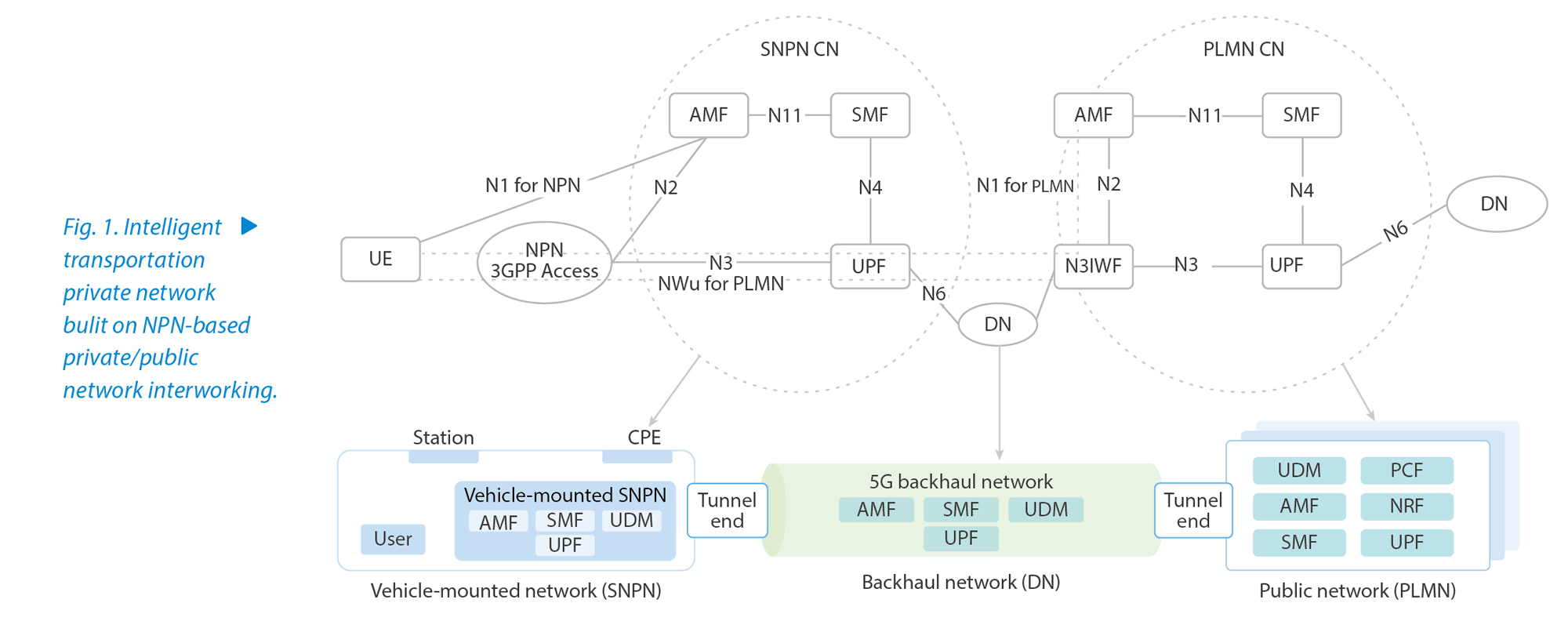By the end of 2020, the length of China's railways in service had reached 146,300 km, of which the length of high-speed railways had reached 38,000 km. High-speed rails have become a "new business card" of China. Due to high-speed movement as well as signal shielding, loss and frequency shift by metal vehicles, 5G network coverage is facing great challenges in the transportation represented by high-speed rails, subways, and airplanes. If a 5G network is directly deployed inside the transportation vehicle and moves with it, there will be no penetration loss, Doppler shift or frequent handover. This can address 5G connection needs of a large number of sensors and cameras in transportation vehicles such as high-speed rails and airplanes, and meet the needs of wiring and maintenance as well.
However, for public users, both network registration and control are implemented in the ground 5G public network. If the private network inside the transportation vehicle is used to access the 5G network, it is necessary to solve the problem of interworking between the private network on the high-speed mobile vehicle and the static ground network.
In the 5G protocols defined by 3GPP, the concept of non-public network (NPN) is put forward, and the interworking solution between stand-alone NPN (SNPN) and public land mobile network (PLMN) is described accordingly. As shown in Fig. 1, SNPN is regarded as a non-3GPP access point of PLMN, and an encrypted tunnel is established between the data network (DN) and the non-3GPP interworking function (N3IWF) in the public network, thus realizing the interworking between NPN (private network) and PLMN (public network) while maintaining their relative independence.

In this architecture, SNPN, PLMN and DN are all relatively independent, which is of great reference significance to the construction of a high-speed mobile transportation network. If the transportation network is divided into three parts, the network inside the carriage can be regarded as a SNPN, and the ground network as a PLMN. The backhaul channel between the carriage network and the ground network can be built through the DN along the track.
In the carriage network part, lightweight i5GC products can be used to deploy SNPN, and high-performance CPEs can be used at the tunnel end, with CPE antenna extending to the outside of the carriage. This eliminates signal attenuation caused by the penetration loss in the carriage.
The backhaul network can be covered by the existing 5G network along the track or built with large bandwidth (millimeter wave). Based on the backhaul network (DN), an IPSec tunnel is established between the UPF of vehicle-mounted SNPN and the N3IWF of PLMN to connect the moving carriage with the static ground.
Assuming that the user is anchored on PLMN (the same as the one anchored on SNPN), it can be understood as a handover. The movement of public users, such as passengers getting on/off the train, can be regarded as a network handover, that is, getting on the train means a handover from PLMN to SNPN, while getting off the train means a handover from SNPN to PLMN.
In the high-speed rail scenario, compared with the standard NPN solution, SNPN can be evolved into a private high-speed rail network solution, and the control plane of SNPN can be moved to the ground. In this way, the interworking between SNPN and PLMN is relatively static, and the route interworking solution can be directly adopted. The small carriage station used as the SNPN base station connects the carriage UPF to unload the video content of the same quality. The backhaul channel between the carriage (SNPN-UPF) and the private high-speed rail network (SNPN-control plane) uses 5G coverage along the way. The SNPN control plane on the ground serves as a convergence point to connect a large number of trains while interworking with PLMN, thus avoiding direct multipoint-to-multipoint tunnel connection between trains and PLMN. This simplifies network topology, reduces the complexity of interconnection, and improves network security and reliability.
Similarly, in the subway scenario, the small carriage station serves as the PLMN base station, and SNPN uses millimeter-wave antennas to build a super-large bandwidth backhaul network. This is used for rental by PLMN operators and facilitates existing operators to extend their network services to subway carriage.
In the aviation scenario, since PLMN cannot cover the flight altitude, the air-to-ground (ATG) network based on SNPN can be specially built as the backhaul network. As a backhaul network user, CPE in the aircraft cabin can offer Wi-Fi service directly to the Wi-Fi users in the cabin, and can provide VoWi-Fi service for the mobile phone with the support of the ground network. Moreover, the CPE can build a backhaul tunnel with the ground network through the backhaul network. In this way, the connection between PLMN and the airborne SNPN is established, which makes it possible to deliver 5G services directly to the users in the aircraft cabin.
With the further deployment of 5G networks, enjoying convenient 5G services in high-speed vehicles will become a necessity for people. The intelligent transportation private network built on the NPN-based private/public interworking mechanism provides a good solution to signal loss caused by vehicles, handover and frequency shift caused by high-speed movement, user roaming, and handover management mechanism. Building a unified intelligent transportation private network that supports aviation, high-speed rail, and subway will soon make it possible for users to enjoy convenient 5G services in high-speed trains, subways and airplanes.